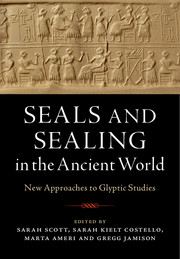 Seals and Sealing in the Ancient World
Seals and Sealing in the Ancient World Book contents
- Seals and Sealing in the Ancient World
- Seals and Sealing in the Ancient World
- Copyright page
- Contents
- Notes on Contributors
- Illustrations
- Plates
- Tables
- Acknowledgments
- Preface
- Abbreviations
- Chapter One Introduction: Small Windows, Wide Views
- Part I The Ancient Near East and Cyprus
- Chapter Two Administrative Role of Seal Imagery in the Early Bronze Age: Mesopotamian and Iranian Traders on the Plateau
- Chapter Three Slave Labor: Uruk Cylinder-Seal Imagery and Early Writing
- Chapter Four The First Female Bureaucrats: Gender and Glyptic in Third-Millennium Northern Mesopotamia
- Chapter Five Rematerializing the Early Dynastic Banquet Seal
- Chapter Six Sealing Practices in the Akkadian Period
- Chapter Seven Authenticity, Seal Recarving, and Authority in the Ancient Near East and Eastern Mediterranean
- Part II South Asia and the Gulf Region
- Part III Egypt
- Part IV Aegean
- References
- Endnotes
- Index
Chapter Three - Slave Labor: Uruk Cylinder-Seal Imagery and Early Writing
from Part I - The Ancient Near East and Cyprus
Published online by Cambridge University Press: 24 April 2018
- Seals and Sealing in the Ancient World
- Seals and Sealing in the Ancient World
- Copyright page
- Contents
- Notes on Contributors
- Illustrations
- Plates
- Tables
- Acknowledgments
- Preface
- Abbreviations
- Chapter One Introduction: Small Windows, Wide Views
- Part I The Ancient Near East and Cyprus
- Chapter Two Administrative Role of Seal Imagery in the Early Bronze Age: Mesopotamian and Iranian Traders on the Plateau
- Chapter Three Slave Labor: Uruk Cylinder-Seal Imagery and Early Writing
- Chapter Four The First Female Bureaucrats: Gender and Glyptic in Third-Millennium Northern Mesopotamia
- Chapter Five Rematerializing the Early Dynastic Banquet Seal
- Chapter Six Sealing Practices in the Akkadian Period
- Chapter Seven Authenticity, Seal Recarving, and Authority in the Ancient Near East and Eastern Mediterranean
- Part II South Asia and the Gulf Region
- Part III Egypt
- Part IV Aegean
- References
- Endnotes
- Index
Summary
The emergence of cylinder seals in southern Mesopotamia in the fourth millennium BCE was a new technology vital to temple accounting. During the proto-literate period the type of information carried by the seals and their impressions changed; as this happened the first numerical notations and inscribed “proto-writing” emerged. Assyriologists have examined the development of the numerical systems and “proto-writing,” while art historians and archaeologists examine the meaning and function of seal imagery. This chapter analyzes Uruk seal imagery in conjunction with numerical and “proto-writing” technologies to reveal the interconnectedness of seal and inscription as a larger accounting system. It is concluded that the introduction of numerical and ideographic signs occurred simultaneously with a change in the symbolic value of seal imagery, and that the meaning of seal imagery was linked to commodity recording and carried clues regarding social connotations.
- Type
- Chapter
- Information
- Seals and Sealing in the Ancient WorldCase Studies from the Near East, Egypt, the Aegean, and South Asia, pp. 36 - 53Publisher: Cambridge University PressPrint publication year: 2018
- 2
- Cited by
